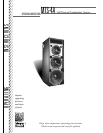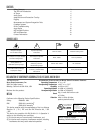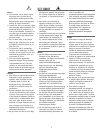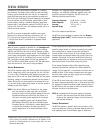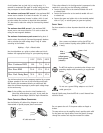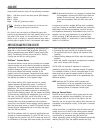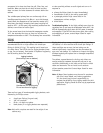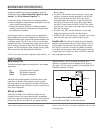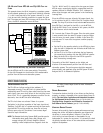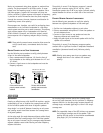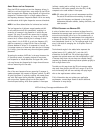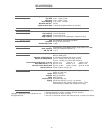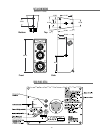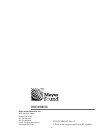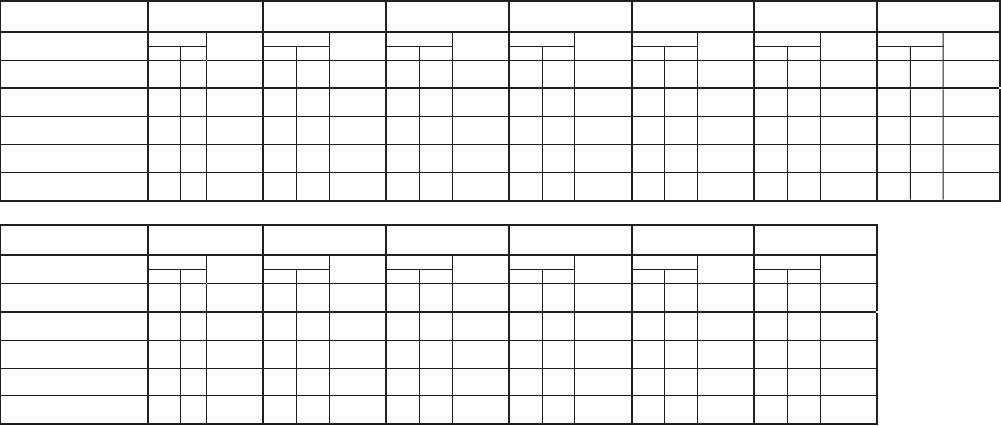
ARRAY DESIGN FOR LOW FREQUENCIES
Since the MTS-4A contains sub and low frequency drivers, in
addition to mid and high drivers, array design for the MTS-4A
must incorporate the different array response of high and low
frequencies. The beam width for a single speaker widens as
the frequency decreases. Frequencies below 125 Hz are mostly
omnidirectional while higher frequencies are more directional.
NOTE: H and V are abbreviations for horizontal and vertical.
The low frequencies of adjacent arrayed speakers exhibit
on-axis addition and off-axis cancellation, resulting in a
narrowing of coverage in the dimension in which they are
arrayed. A H array of two MTS-4As narrows the H coverage
without affecting the V coverage. A V array of two MTS-4As
narrows the V, without affecting the H coverage. In both
cases, there is 3 to 6 dB SPL of on-axis low frequency (LF)
addition compared to a single MTS-4A. Due to the larger
distance between LF drivers in V, compared to H arrays, the
V coverage narrows at a faster rate than does the H coverage
for H arrays, given the same array size and adjacent speaker
placement.
Increasing the number of MTS-4As in the array increases the
LF directional control. A properly designed V array steers
low frequencies to include balconies and upper tiers, while
a H array focuses low frequencies for longer throw distances
without interacting with the walls.
LOADING
One of the most important factors governing LF response is
speaker placement with respect to adjacent surfaces. The MTS-
4A gains significant LF power by coupling with nearby floors
and walls. Half-space loading describes a speaker coupling
with one surface. Speakers placed on the floor benefit
from half-space loading, while flown speakers in free-space
(without a nearby wall or ceiling) do not. In general,
subwoofers in half-space generate twice the SPL (+6 dB)
compared to the same number in free-space.
NOTE: SPL values refer to an on-axis measurement position.
The actual SPL addition and narrowing of coverage
varies with frequency and depends on the physical
displacement between cabinets, loading conditions, and
room acoustics.
MTS-4A COVERAGE AND MAXIMUM SPL
A series of outdoor tests was conducted at Meyer Sound to
determine the coverage angle and on-axis SPL for arrays with
one and two horizontal rows of up to five speakers each, at
numerous splay angles. The measurements were conducted at
a distance of 8 m with half-space loading; on-axis SPL values
were interpolated from 8 to 1 m. The coverage angle for the
array is the result of averaging the –6 dB points from 125
Hz to 8 kHz.
The horizontal angles in the tables below represent the
optimal narrow (15°), middle (30°), and wide (45°)
orientations for the MTS-4A. The vertical splay angles
represent the optimal narrow and wide configurations. 2@0°
LT denotes long throw: the two horns are coupled directly
together (top speaker upside down/bottom speaker upright) to
form a single narrow horn.
The table on this page shows the SPL and coverage angles
that result from grouping the MTS-4A in arrays of up to five
units horizontally and two rows vertically. All splay angles
refer to the angle between cabinet centers.
If this information does not address your application
requirements, contact Meyer Sound to obtain additional
information on array design.
MTS-4A Array Coverage and Maximum SPL
Number of Horizontal
MTS-4As @ Angle
1 2 @ 15˚ 2 @ 30˚ 2 @ 45˚ 3 @ 15˚ 3 @ 30˚ 3 @ 45˚
Coverage Max Peak Coverage Max Peak Coverage Max Peak Coverage Max Peak Coverage Max Peak Coverage Max Peak Coverage Max Peak
H V dB SPL H V dB SPL H V dB SPL H V dB SPL H V dB SPL H V dB SPL H V dB SPL
Vertical Rows of MTS-4As
@ Angle
1 70˚ 60˚ 140 50˚ 60˚ 146 60˚ 60˚ 145 100˚ 60˚ 142 80˚ 60˚ 149 120˚ 60˚ 147 150˚ 60˚ 145
2 @ 0˚ (LT) 70˚ 30˚ 146 50˚ 30˚ 152 60˚ 30˚ 151 100˚ 30˚ 148 80˚ 30˚ 155 120˚ 30˚ 153 150˚ 30˚ 151
2 @ 15˚ 70˚ 50˚ 145 50˚ 50˚ 151 60˚ 50˚ 150 100˚ 50˚ 147 80˚ 50˚ 154 120˚ 50˚ 152 150˚ 50˚ 150
2 @ 30˚ 70˚ 90˚ 143 50˚ 90˚ 149 60˚ 90˚ 148 100˚ 90˚ 145 80˚ 90˚ 152 120˚ 90˚ 150 150˚ 90˚ 148
Number of Horizontal
MTS-4As @ Angle
4 @ 15˚ 4 @ 30˚ 4 @ 45˚ 5 @ 15˚ 5 @ 30˚ 5 @ 45˚
Coverage Max Peak Coverage Max Peak Coverage Max Peak Coverage Max Peak Coverage Max Peak Coverage Max Peak
H V dB SPL H V dB SPL H V dB SPL H V dB SPL H V dB SPL H V dB SPL
Vertical Rows of MTS-4As
@ Angle
1 100˚ 60˚ 151 140˚ 60˚ 148 190 60˚ 146 110˚ 60˚ 153 180˚ 60˚ 148 240 60˚ 146
2 @ 0˚ (LT) 100˚ 30˚ 157 140˚ 30˚ 154 190 30˚ 152 110˚ 30˚ 159 180˚ 30˚ 154 240 30˚ 152
2 @ 15˚ 100˚ 50˚ 156 140˚ 50˚ 153 190 50˚ 151 110˚ 50˚ 158 180˚ 50˚ 153 240 50˚ 151
2 @ 30˚ 100˚ 90˚ 154 140˚ 90˚ 151 190 90˚ 149 110˚ 90˚ 156 180˚ 90˚ 151 240 90˚ 149
11



